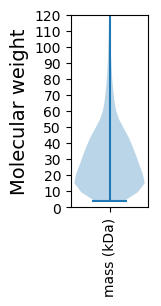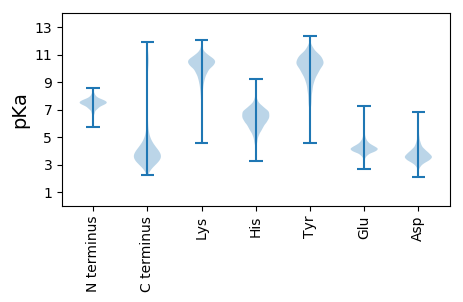
Candidatus Glomeribacter gigasporarum BEG34
Taxonomy: cellular organisms; Bacteria; Proteobacteria; Betaproteobacteria; Burkholderiales; Burkholderiaceae; Candidatus Glomeribacter; Candidatus Glomeribacter gigasporarum
Average proteome isoelectric point is 7.4
Get precalculated fractions of proteins

Virtual 2D-PAGE plot for 1471 proteins (isoelectric point calculated using IPC2_protein)
Get csv file with sequences according to given criteria:
* You can choose from 21 different methods for calculating isoelectric point
Summary statistics related to proteome-wise predictions



Protein with the lowest isoelectric point:
>tr|G2JB08|G2JB08_9BURK Uncharacterized protein OS=Candidatus Glomeribacter gigasporarum BEG34 OX=1070319 GN=CAGGBEG34_340005 PE=4 SV=1
MM1 pKa = 7.62IEE3 pKa = 3.84GAGNFGYY10 pKa = 10.59NAATGEE16 pKa = 4.29YY17 pKa = 9.58GDD19 pKa = 4.94LMQAGVVDD27 pKa = 3.92PTKK30 pKa = 10.02VTRR33 pKa = 11.84TALQNAASVAGLLLMTDD50 pKa = 4.18CAVCEE55 pKa = 4.23LPKK58 pKa = 10.77DD59 pKa = 3.78DD60 pKa = 4.37TPAPGSMPGGGMGSMGMDD78 pKa = 3.22MM79 pKa = 5.48
MM1 pKa = 7.62IEE3 pKa = 3.84GAGNFGYY10 pKa = 10.59NAATGEE16 pKa = 4.29YY17 pKa = 9.58GDD19 pKa = 4.94LMQAGVVDD27 pKa = 3.92PTKK30 pKa = 10.02VTRR33 pKa = 11.84TALQNAASVAGLLLMTDD50 pKa = 4.18CAVCEE55 pKa = 4.23LPKK58 pKa = 10.77DD59 pKa = 3.78DD60 pKa = 4.37TPAPGSMPGGGMGSMGMDD78 pKa = 3.22MM79 pKa = 5.48
Molecular weight: 7.93 kDa
Isoelectric point according different methods:
Protein with the highest isoelectric point:
>tr|G2JC37|G2JC37_9BURK Putative bacteriophage tail protein GpP Mu-like OS=Candidatus Glomeribacter gigasporarum BEG34 OX=1070319 GN=CAGGBEG34_900001 PE=4 SV=1
MM1 pKa = 8.01IGQLWMAEE9 pKa = 4.14FAQVRR14 pKa = 11.84QRR16 pKa = 11.84SGAQTRR22 pKa = 11.84QRR24 pKa = 11.84SGAQVARR31 pKa = 11.84VVTNVVMMGMGEE43 pKa = 3.98PLLNFDD49 pKa = 3.9AVVRR53 pKa = 11.84ALRR56 pKa = 11.84LMLDD60 pKa = 3.52DD61 pKa = 3.86NAYY64 pKa = 8.67GLSRR68 pKa = 11.84RR69 pKa = 11.84RR70 pKa = 11.84VTVSTSGVVPMMDD83 pKa = 4.04RR84 pKa = 11.84LAQQLPVSLAVSLHH98 pKa = 6.3APDD101 pKa = 5.15DD102 pKa = 4.03ALRR105 pKa = 11.84DD106 pKa = 3.67ALVPLNKK113 pKa = 9.91KK114 pKa = 10.01YY115 pKa = 10.22PLRR118 pKa = 11.84EE119 pKa = 3.96LMRR122 pKa = 11.84ACQRR126 pKa = 11.84YY127 pKa = 9.06LKK129 pKa = 10.34AAPRR133 pKa = 11.84DD134 pKa = 4.09FITFEE139 pKa = 4.0YY140 pKa = 10.88CMLAGINDD148 pKa = 4.01HH149 pKa = 6.51EE150 pKa = 4.39KK151 pKa = 10.42HH152 pKa = 5.95ARR154 pKa = 11.84QLLALVQEE162 pKa = 5.05IPCKK166 pKa = 10.53FNLIPFNPFPEE177 pKa = 4.47SGFTRR182 pKa = 11.84SAPEE186 pKa = 3.55QIRR189 pKa = 11.84RR190 pKa = 11.84FAQILSARR198 pKa = 11.84GIVTTIRR205 pKa = 11.84KK206 pKa = 7.42TRR208 pKa = 11.84GDD210 pKa = 4.95DD211 pKa = 2.93IDD213 pKa = 3.99AACGQLAGIVNDD225 pKa = 3.88RR226 pKa = 11.84THH228 pKa = 6.78LAMRR232 pKa = 11.84NRR234 pKa = 11.84TAQIQAARR242 pKa = 11.84RR243 pKa = 11.84TITIHH248 pKa = 5.33PQQ250 pKa = 2.68
MM1 pKa = 8.01IGQLWMAEE9 pKa = 4.14FAQVRR14 pKa = 11.84QRR16 pKa = 11.84SGAQTRR22 pKa = 11.84QRR24 pKa = 11.84SGAQVARR31 pKa = 11.84VVTNVVMMGMGEE43 pKa = 3.98PLLNFDD49 pKa = 3.9AVVRR53 pKa = 11.84ALRR56 pKa = 11.84LMLDD60 pKa = 3.52DD61 pKa = 3.86NAYY64 pKa = 8.67GLSRR68 pKa = 11.84RR69 pKa = 11.84RR70 pKa = 11.84VTVSTSGVVPMMDD83 pKa = 4.04RR84 pKa = 11.84LAQQLPVSLAVSLHH98 pKa = 6.3APDD101 pKa = 5.15DD102 pKa = 4.03ALRR105 pKa = 11.84DD106 pKa = 3.67ALVPLNKK113 pKa = 9.91KK114 pKa = 10.01YY115 pKa = 10.22PLRR118 pKa = 11.84EE119 pKa = 3.96LMRR122 pKa = 11.84ACQRR126 pKa = 11.84YY127 pKa = 9.06LKK129 pKa = 10.34AAPRR133 pKa = 11.84DD134 pKa = 4.09FITFEE139 pKa = 4.0YY140 pKa = 10.88CMLAGINDD148 pKa = 4.01HH149 pKa = 6.51EE150 pKa = 4.39KK151 pKa = 10.42HH152 pKa = 5.95ARR154 pKa = 11.84QLLALVQEE162 pKa = 5.05IPCKK166 pKa = 10.53FNLIPFNPFPEE177 pKa = 4.47SGFTRR182 pKa = 11.84SAPEE186 pKa = 3.55QIRR189 pKa = 11.84RR190 pKa = 11.84FAQILSARR198 pKa = 11.84GIVTTIRR205 pKa = 11.84KK206 pKa = 7.42TRR208 pKa = 11.84GDD210 pKa = 4.95DD211 pKa = 2.93IDD213 pKa = 3.99AACGQLAGIVNDD225 pKa = 3.88RR226 pKa = 11.84THH228 pKa = 6.78LAMRR232 pKa = 11.84NRR234 pKa = 11.84TAQIQAARR242 pKa = 11.84RR243 pKa = 11.84TITIHH248 pKa = 5.33PQQ250 pKa = 2.68
Molecular weight: 28.05 kDa
Isoelectric point according different methods:
Peptides (in silico digests for buttom-up proteomics)
Below you can find in silico digests of the whole proteome with Trypsin, Chymotrypsin, Trypsin+LysC, LysN, ArgC proteases suitable for different mass spec machines.| Try ESI |
 |
|---|
| ChTry ESI |
 |
|---|
| ArgC ESI |
 |
|---|
| LysN ESI |
 |
|---|
| TryLysC ESI |
 |
|---|
| Try MALDI |
 |
|---|
| ChTry MALDI |
 |
|---|
| ArgC MALDI |
 |
|---|
| LysN MALDI |
 |
|---|
| TryLysC MALDI |
 |
|---|
| Try LTQ |
 |
|---|
| ChTry LTQ |
 |
|---|
| ArgC LTQ |
 |
|---|
| LysN LTQ |
 |
|---|
| TryLysC LTQ |
 |
|---|
| Try MSlow |
 |
|---|
| ChTry MSlow |
 |
|---|
| ArgC MSlow |
 |
|---|
| LysN MSlow |
 |
|---|
| TryLysC MSlow |
 |
|---|
| Try MShigh |
 |
|---|
| ChTry MShigh |
 |
|---|
| ArgC MShigh |
 |
|---|
| LysN MShigh |
 |
|---|
| TryLysC MShigh |
 |
|---|
General Statistics
Number of major isoforms |
Number of additional isoforms |
Number of all proteins |
Number of amino acids |
Min. Seq. Length |
Max. Seq. Length |
Avg. Seq. Length |
Avg. Mol. Weight |
|---|---|---|---|---|---|---|---|
0 |
429475 |
31 |
5058 |
292.0 |
32.25 |
Amino acid frequency
Ala |
Cys |
Asp |
Glu |
Phe |
Gly |
His |
Ile |
Lys |
Leu |
|---|---|---|---|---|---|---|---|---|---|
12.212 ± 0.111 | 1.219 ± 0.025 |
4.862 ± 0.043 | 5.43 ± 0.055 |
3.753 ± 0.037 | 6.946 ± 0.072 |
2.586 ± 0.042 | 5.625 ± 0.052 |
3.851 ± 0.051 | 10.663 ± 0.088 |
Met |
Asn |
Gln |
Pro |
Arg |
Ser |
Thr |
Val |
Trp |
Tyr |
|---|---|---|---|---|---|---|---|---|---|
2.398 ± 0.034 | 2.998 ± 0.047 |
4.921 ± 0.05 | 4.56 ± 0.048 |
7.432 ± 0.071 | 5.489 ± 0.049 |
4.886 ± 0.042 | 6.179 ± 0.057 |
1.369 ± 0.028 | 2.616 ± 0.033 |
Most of the basic statistics you can see at this page can be downloaded from this CSV file
Proteome-pI is available under Creative Commons Attribution-NoDerivs license, for more details see here
| Reference: Kozlowski LP. Proteome-pI 2.0: Proteome Isoelectric Point Database Update. Nucleic Acids Res. 2021, doi: 10.1093/nar/gkab944 | Contact: Lukasz P. Kozlowski |
